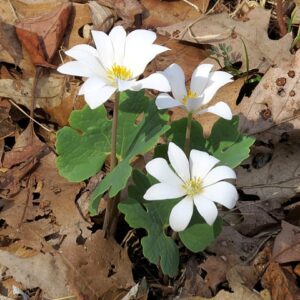We are going wild for wildflowers. You may see lots of flowers blooming in yards and gardens, but we are going to explore what is blooming in fields and forests.
learn.
A wildflower is a flower that grows without any help from people, they grow naturally in their environment. People may grow wildflowers in their garden, but most wildflowers are native plants and grow in woods, meadows, wetlands – anywhere they adapted to grow.
Native plants are essential in nature, because they provide food and habitat for animals of all kinds, including humans. They filter the air and reduce soil erosion. Because native plants fill a niche, or specific function, within their ecosystem, they seldom grow beyond the needs and capacities of that ecosystem.
nature id.
This is one of the first native wildflowers you will see blooming in our woods. It is named for the color of it’s sap. Any guess as to what it’s called?

Photo by Carole Mebus
Answer: This bloodroot was found at Mariton Wildlife Sanctuary. Bloodroot is one of many plants whose seeds are spread by ants. The seeds have a fleshy organ called an elaiosome that attracts ants, where the ants will take the seeds to their nest, where they eat the elaiosomes, and put the seeds in their nest debris. The seed then is protected until they germinate. They also benefit from growing in a medium made richer by the ant nest debris.
play.
Grow your own wildflower garden. You can find native plants and seed mixes online or at your local garden center. Natives are a wonderful way to go. You don’t have to grow a lot to make a BIG difference. You will be kind to the environment, and what a wonderful way to spend an afternoon watching butterflies flit around your yard.
The Department of Conservation and Natural Resources has a great list of PA native plant nurseries and online stores.
If you go with seeds and are not worried about getting dirty, make seed bombs. Click here for instructions.
